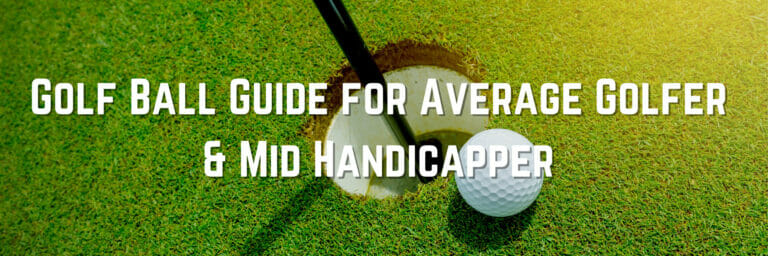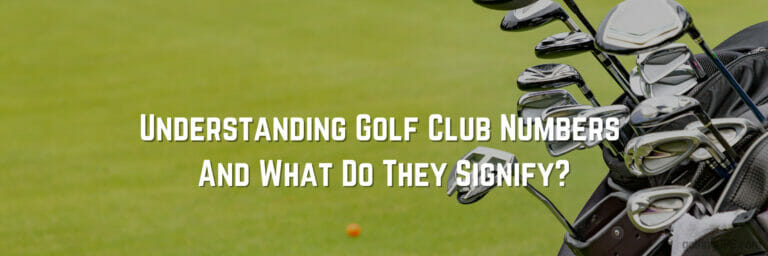A Complete Guide To Golf Balls For Beginner Golfers & High Handicappers
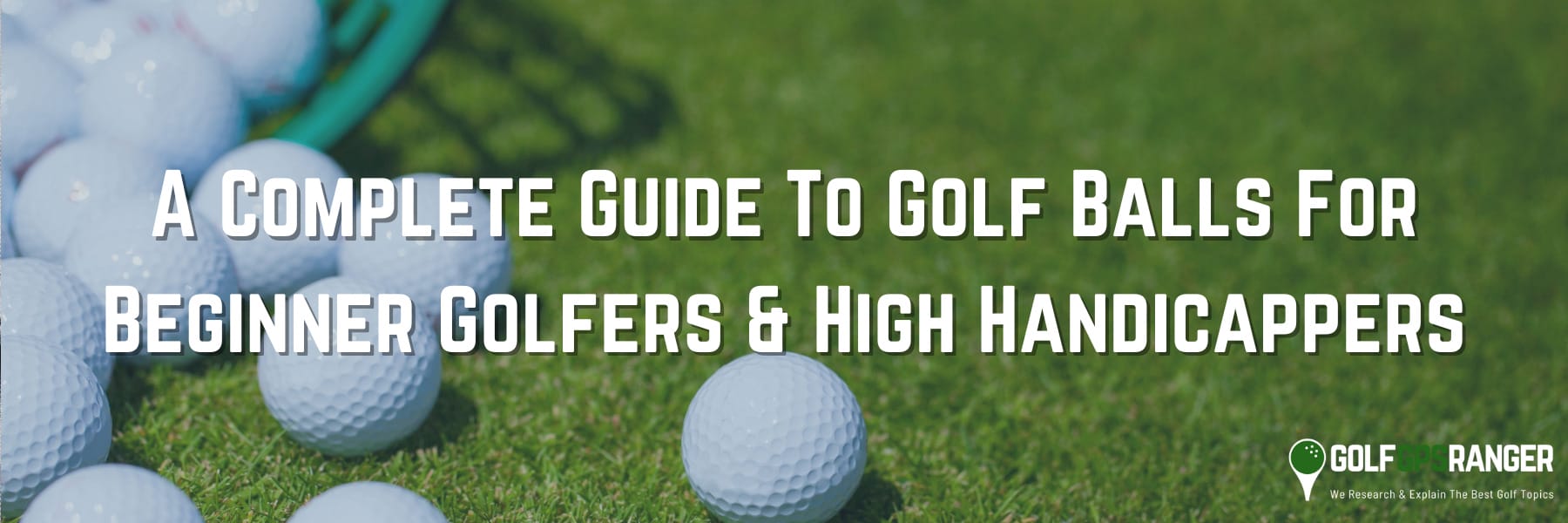
!!!!DISCLAIMER!!!! This site may contain Amazon & other affiliate links.
This means if you click on one of the product recommendation links, this site may receive a small commission. This is at no extra cost to you and may include exclusive discounts when possible. This helps support this site and allows us to keep making content like this. Thank you for your support!
Welcome to our guide on finding the best golf balls for beginners. If you’re starting or want to get better at golf, the right ball is key. We will look into golf balls for new players, including their importance, types, and what to consider.
There are many things to think about when choosing golf balls. These include type, how they are made, how hard they are, and what covers them. Knowing about these can help you do better on the golf course.
We’ll explain why picking the right ball is essential and how you can choose wisely as a new golfer.
Beginner Ball Guide
- Match the ball to your skill level and swing speed.
- Start with two-piece balls for their balance of distance and strength.
- Try out different balls to see what works best for you.
- Ball compression impacts its performance in terms of distance, spin, and feel.
- Pick a dimple pattern that suits your swing and enhances flight.
- For covers, Surlyn lasts longer and goes further.Urethane gives more spin and feel.
- Consider your budget, but know higher-quality balls can help as you improve.
Golf Balls for Beginners
Every piece of golf gear influences your game, including the ball you use. Beginners often focus on improving their swing and technique. Yet, the right golf ball is just as critical. It impacts your distance, control, and how the game feels overall.
Ball Type

The right golf ball can make a big difference in your play. There are many ball designs that offer unique features. Some are made to fly far, while others are built for precise shots. With the best ball for you, you’ll play to your strengths and level up your game.
Golf Ball Construction
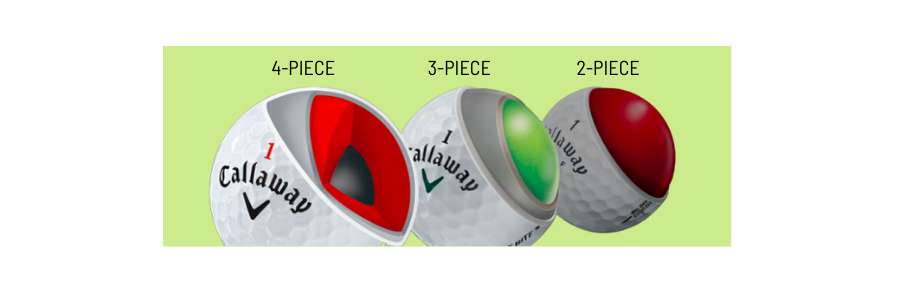
Golf balls are made of several layers, including a core, mantle, and cover. Each material in these layers affects how the ball compresses, spins, and feels. Knowing this lets beginners pick a ball that fits their game. This choice can boost their performance on the course.
Skill Level and Swing Speed
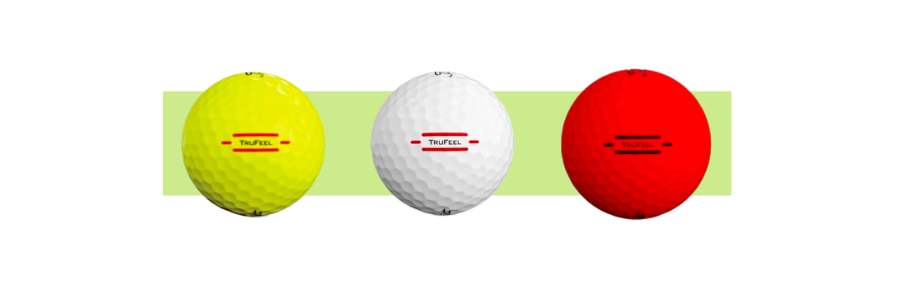
It’s vital to pick a ball that suits your skill and how fast you swing. Beginners and pros have different needs. Using the right ball can help you play better. For instance, if you’re a beginner with a slower swing, you might want a lower compression ball. This can help you hit with more distance and control.
Source: Academy’s Research on Choosing a Golf Ball
Types of Golf Balls
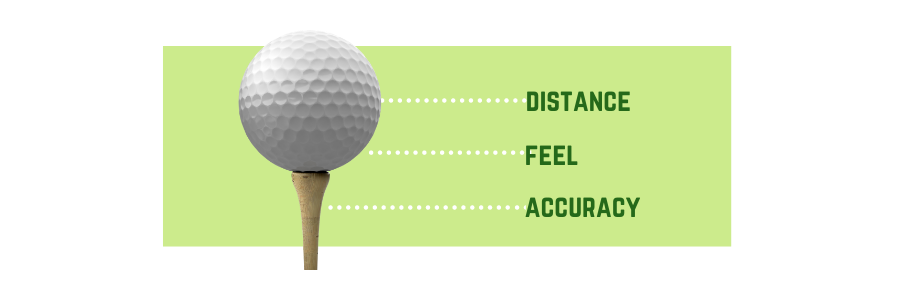
Choosing the right golf ball for new players means knowing the differences. Each type has unique features that affect how a new golfer plays.
Two-Piece and Three-Piece Golf Balls
Golf balls come in two-piece and three-piece types. This difference is about how they’re built and their layers.
Two-piece Golf Balls: Two-piece golf balls have a solid core and tough cover. They’re great for distance and are very durable. For beginners, they are easier to hit straight because they don’t spin much.
Three-piece Golf Balls: Three-piece balls have a solid core, a middle layer, and soft cover. They offer more control and spin. This is good for those looking to shape their shots but might be harder for beginners to hit far.
Soft Golf Balls
Golf balls’ softness is important for new players. Soft balls help with feel and performance.
Soft Golf Balls: Soft golf balls feel gentler when hit. They give more feedback on each hit, helping beginners learn. They also spin more, offering better control near the green.
For new golfers, this soft feel can boost confidence and make the game more enjoyable.
Distance vs. Control
Choosing between distance and control is key for beginner golfers. It’s about what matters most to each player.
Distance-oriented golf balls: These balls aim to go far from the tee. They lower spin for longer shots. But, they might be harder to control near the green for beginners.
Control-oriented golf balls: These focus on shaping shots and controlling the ball near the green. They offer more spin. They help beginners become more precise in their play, though they might not go as far.
The decision between distance and control depends on how a beginner likes to play and their goals.
| Type of Golf Ball | Main Features |
| Two-piece Golf Balls | Optimized for distance and durability, ideal for beginners with slower swing speeds |
| Three-piece Golf Balls | Offers better control and spin, suitable for beginners seeking shot-shaping capability |
| Soft Golf Balls | Provides a softer feel and better feedback, enhances control and spin around the greens |
| Distance-oriented Golf Balls | Maximizes distance off the tee, sacrifices some control and feel around the greens |
| Control-oriented Golf Balls | Prioritizes control and feel, better shot shaping and greenside control |
Source: Todaysgolfer’s Research on Beginners Ball
Golf Ball for Your Playing Style
Finding the right golf ball for your style can boost your game. Consider your swing speed, play near the green, and the course type. This will help you discover the ideal ball to improve your play.
Analyzing Your Swing Speed
Knowing your swing speed is crucial when selecting a golf ball. Each ball is designed for specific swing speeds. To determine your average speed, use a launch monitor or consult a professional. By choosing a ball that complements your swing, you can improve your distance and accuracy on the course.
Benefits:
- Improved shot consistency
- Increased driving distance
- Better overall performance on the course
Improve Your Game
To enhance your short game, look for a ball with good feel and spin. Softer balls with urethane covers provide better spin and control, which is essential for chip shots and putts. By using a ball that suits your needs around the green, you can make closer, more accurate shots and ultimately lower your scores.
Advantages:
- Improved accuracy on approach shots
- Better control on chip shots and putts
- Lower scores due to enhanced short game performance
Considering the Conditions
Golf courses feature different ground conditions, ranging from soft to hard. Understanding how balls react to these conditions can help you adapt your game. For soft areas, choose a low-compression ball with high spin for better distance and control. When playing on hard fairways, opt for a high-compression ball that provides more roll on your shots.
Positive Outcomes:
- Optimized performance based on course conditions
- Improved distance control on various fairways
- Adapting your ball choice to the course leads to better overall scores
| Golf Ball Type | Swing Speed Recommendation | Game Around the Green | Performance in Various Conditions |
| Low Compression | Slow-Medium | Excellent control and feel | Optimal performance on soft and wet fairways |
| Medium Compression | Medium | Good balance of distance and control | Reliable performance on a variety of fairway conditions |
| High Compression | Fast | Added distance off the tee | Maximized roll and distance on firm and fast fairways |
Understanding Golf Ball Selection
Choosing the right golf ball can be tough, especially for new players. There’s a lot of fancy talk in the world of golf balls. We’re here to help you understand it all. We will talk about terms you need to know, how golf balls get rated, and the benefits of talking to a golf expert.
Dimple, Urethane, Surlyn, and More

Beginners might find terms like dimple, urethane, Surlyn, and others confusing. Let’s break it down:
Dimple: Dimples on a golf ball matter a lot. They help the ball go further and straighter by reducing drag.
Urethane: Urethane covers are great for adding spin and give more control near the greens. You’ll often see them on high-end balls.
Surlyn: Surlyn is good for durability and distance. Cheaper balls often use it.
Golf Ball Ratings
Understanding golf ball ratings is key. It helps beginners pick the right ball. Let’s look at some ratings and what they tell us:
- A ball’s compression rating affects feel and performance. Low compression (below 80) is softer and may help beginners hit farther. High compression (above 90) gives more control and suits advanced players better.
- Ball speed is about how fast the ball flies off the club. A higher rating means longer shots.
- Spin affects how the ball moves in the air and on the ground. Less spin is good for more distance. More spin helps with control but might shorten your shots.
Consulting With a Golf Expert
Our guide is great for beginners, but sometimes you need a pro’s advice. They can help choose a ball that fits you perfectly. Here are times when talking to an expert is smart:
- When you have special needs because of your body or any injuries.
- When you want to improve your game and need help with picking balls.
- If you’re curious about cutting-edge golf ball tech and features.
Chatting with a golf expert can really up your game. They ensure you make smart choices and find the right ball for you.
Golf Ball Compression
Compression is key when picking the best golf ball. It looks at how dense the ball is and what happens when you hit it. This can change a beginner’s game a lot, affecting things like distance, spin, and how the hit feels.
What is Golf Ball Compression and Why Does it Matter?
Compression shows how soft or hard a golf ball is. It’s a number between 40 to 100. Lower numbers mean the ball is less compressed. Higher numbers mean it’s more compressed. This number affects the ball’s behavior when the club hits it.
For starters, the compression level of the ball is crucial. It affects how high the ball launches, its speed, and how well it travels. The right compression level can boost a beginner’s performance on the field.
| Factor | Low Compression Golf Balls | High Compression Golf Balls |
|---|---|---|
| Suitable for | Beginners and players with slower swings | Players with faster swings |
| Forgiveness | More forgiving on off-center hits | Less forgiving |
| Compression | Compress easily on impact | Harder and less compressible |
| Benefits for Beginners | Help generate more speed and distance | Offer more control but may be too hard for beginners |
| Distance | Can travel further due to softness | May sacrifice distance for beginners |
| Spin | Generate more spin | Create lower launch angles and less spin |
| Feel | Softer feel | Firmer feel |
| Ideal for | Players who don’t swing too fast | Players who know how to work the ball |
| Potential Drawbacks for Beginners | None mentioned | May result in less distance and a less satisfying hit |
Figuring out the best compression for your game is important. Trying various balls and seeing what happens is a smart move. This experimentation can help newbies find the right fit for their play style.
The Role of Dimples in Golf Ball
Dimples aren’t just for looks on a golf ball. They actually help with how the ball flies. The tiny dents on the surface change how air flows around the ball.
Aerodynamics and Ball Flight
The way the dimples are arranged helps the ball slice through the air. These tiny bumps make the air swirl around the ball. This makes the ball go farther and fly straighter.
How many dimples and their size affects how high the ball goes and how it spins in the air. Changing the dimple pattern changes the lift and spin. This helps the ball fly better and stay in the air longer.
| Factor | Description |
|---|---|
| Dimple Count | – Golf balls can have between 300 to 500 dimples – For beginners, the number of dimples is not a significant concern – More dimples can help the ball move through the air more smoothly |
| Dimple Depth | – Dimple depth affects the ball’s trajectory – Deeper dimples can help the ball achieve higher trajectories and travel farther – It’s important to find a dimple depth that also maintains the ball’s durability |
| Dimple Design | – There are various dimple designs available, each designed to enhance specific aspects of the ball’s performance – Beginners should choose a dimple design that suits their playing style and preferences – Consulting with a golf professional can help beginners select the most appropriate dimple design for their game |
| Dimple Pattern | – Dimple patterns can vary, including spherical, hexagonal, or tetrahedral designs – Different dimple patterns can affect the ball’s aerodynamics and flight characteristics – Beginners may benefit from a dimple pattern that promotes a consistent and stable ball flight |
Experimenting
- As beginners gain more experience, they can experiment with different dimple counts, depths, designs, and patterns
- Testing various golf balls can help players find the combination that best suits their swing and playing style
- Keeping track of performance with different golf balls can help beginners make informed decisions when selecting their preferred ball
For starters, a simple, round dimple design is usually good. It helps with distance and control. But as you get better, trying different dimple designs can help match the ball to your game.
Golf Ball Covers: Surlyn vs Urethane
Two main types of golf ball covers are popular – Surlyn and urethane. Each has its own set of advantages designed for various player skills and styles.
Surlyn Covers: Durability and Distance
- Beginners often prefer Surlyn covers for their durability and long distance shots
- Surlyn covers are resistant to cuts and damage, ensuring the ball remains playable for longer
- Balls with Surlyn covers tend to fly further off the tee, making them ideal for beginners looking to cover more ground
- Surlyn covers are known for their longevity, providing excellent value for novice golfers
Urethane Covers: Spin and Feel
- Advanced players often choose urethane covers for enhanced spin and control
- The softness of urethane allows for precise shot-stopping on the greens
- Urethane covers provide players with a better feel for their shots, which is crucial for those focusing on accuracy and shot-shaping
- The increased spin generated by urethane covers enables advanced players to execute more challenging shots around the greens
Hybrid Covers: Best of Both Worlds
- Some golf ball manufacturers now offer hybrid covers, which combine the benefits of both Surlyn and urethane
- Hybrid covers aim to provide a balance of distance, spin, and feel
- These covers are suitable for players seeking a well-rounded performance from their golf ball
- However, it’s important to note that hybrid covers may not excel in specific areas to the same extent as specialized Surlyn or urethane covers
- Hybrid covers can be a good option for players transitioning from beginner to intermediate skill levels
Choosing between Surlyn and urethane depends on skill and preference. For beginners, the hardiness and distance from Surlyn are key. Meanwhile, those after more control go for urethane. Hybrids give a mix for those wanting a little of everything. It’s crucial to experiment and find what works best for your game.
Budget-Friendly Golf Balls
If you’re new to golf and want to improve without spending too much, you’re in luck. Many budget golf balls are available that won’t hurt your wallet.
They strike a good balance between cost and quality, perfect for novice players.
Top Affordable Golf Balls
There are several budget-friendly golf balls made just for beginners. They offer great performance and are easy on the wallet.
Some top picks include:
- Srixon Soft Feel Golf Balls
- Callaway Supersoft Golf Balls
- Wilson Staff Duo Golf Balls
- TaylorMade Noodle Golf Balls
- Bridgestone e6 Golf Balls
These balls focus on giving beginners the best distance, control, and feel. They’re perfect for those looking to upgrade their game affordably.
What to Look For
When you’re on the hunt for budget-friendly golf balls, it’s key to find a middle ground between cost and quality. Here are some things to think about:
- Construction: Aim for durable balls that keep their quality over many rounds.
- Compression: Choose balls with a mid to low compression for a softer touch.
- Dimple Design: Opt for balls with smart dimple designs to help your shots fly true.
- Brand Reputation: Look for balls from trusted brands with a track record of high performance.
Thinking about these points will help beginners find the best budget balls. They deliver quality without draining your savings.
Premium Golf Balls
Starting with budget balls is great, but as you get better, you might want to try premium balls. They can offer more, like:
- Extra distance and control
- More spin close to the greens
- Better feel and feedback in your shots
Picking premium balls depends on if the benefits are worth the extra cost.There comes a time when some golfers think it’s a good move.
Yet, don’t forget, your main goal as a beginner is to have fun. Whether you go with budget balls or premium picks, enjoying the game is what counts most. Happy golfing!
Remember, It’s Just the Beginning!
Starting in golf is about getting better and having fun. Don’t stress about doing everything perfectly at first. Enjoy learning, cherish small wins, and pick the best ball for your game.
With a good ball and a can-do attitude, you’ll improve and love golf more!
Frequently Asked Questions (FAQs)
Q: What are the best golf balls for beginners trying to improve their game?
A: For beginners, choosing the right ball is crucial for improving your game. Distance golf balls are often recommended because they are designed to travel farther, even when the golf swing isn’t perfect. Many golfers new to the sport benefit from two-piece construction balls with a durable cover that withstands repeated hits. These golf balls provide a good combination of distance, durability, and affordability.
Q: How do I choose the right ball for my playing style?
A: To choose the right ball for your game, consider your golf swing speed and what you need most on the course. If you’re just starting, you might want a distance ball to help cover more ground. For those who have developed a bit more control, a softer, control ball might be a better choice. Testing different types of golf balls during practice sessions is the best way to see which ball complements your style and skills best.
Q: What is the difference between expensive balls and budget-friendly options?
A: Expensive balls often feature advanced technology and materials, such as a urethane cover versus a surlyn cover, which can significantly affect performance, feel, and control. They are designed for specific performance characteristics, offering benefits like lower spin rates off the tee and higher spin closer to the greens. Budget-friendly balls, like one-piece golf balls or two-piece balls with a durable cover, are designed for durability and distance, catering well to beginners or higher handicappers who might not yet benefit from the nuances of a more expensive ball.
Q: Can the construction of a golf ball affect my performance?
A: Absolutely, the construction of a golf ball can have a significant impact on your performance. For beginners, a two-piece golf ball is often recommended because its construction is tailored for durability and distance – essentials for developing your game. As you advance, you might consider multi-layer balls that offer better control for shots on the green. The moment a ball is hit, its construction influences spin, speed, and trajectory, so selecting one that matches your level and style is key.
Q: Why is it important to understand golf lingo when selecting golf balls?
A: Understanding golf lingo, especially terms related to golf balls, helps you make informed decisions about the right ball for your game. Terms like “compression,” “spin,” and “cover material” can significantly affect how a ball performs. For example, higher compression balls are usually better for players with faster swing speeds, while a ball’s cover material, such as urethane, offers more spin and feel around the greens. Being familiar with this lingo allows you to select a ball that’s designed to meet your specific needs.
Q: How often should a beginner replace their golf balls?
A: The frequency of replacing golf balls depends on their condition and performance. Beginners, who may lose balls more frequently or hit them into obstacles that cause damage, might find themselves replacing balls more often. Generally, if you notice significant wear, such as cuts in the ball’s cover or changes in performance, it’s time for a new ball. As your skills improve and you lose fewer balls, you might choose to play with the same ball longer, or opt for higher-quality, new balls that offer better performance.
Q: Is it worth getting fitted for golf balls like you would for golf clubs?
A: Yes, getting fitted for golf balls can be as beneficial as getting fitted for golf clubs, especially as your game matures and you have specific needs. A ball fitting session typically involves hitting several different types of balls with varying constructions and features to see which works best with your swing and provides the features you need, such as distance or control. Consulting with a golf professional during this process can give you the best insights into which ball is most suitable for your game.
